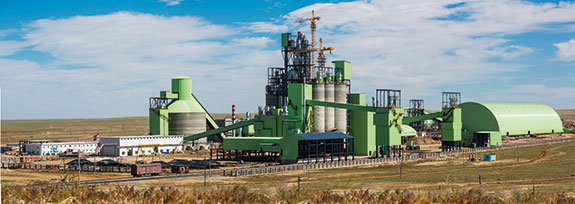Moncement Plant Tour – Part 2
Working around the challenges
Moncement signed an EPC contract with Chinese company Huaxin Cement Co. Ltd in July 2013, having put out a tender worldwide and visited contractors in both Europe and China to conduct due diligence. Site works began in 2014 and at the time of writing, the plant was in the commissioning stages of Phase 1, which will produce at least 1750 tpd of clinker. As mentioned, building the plant was just one aspect of this project. The power supply from the state grid required the construction of a 53 km overhead tension line and substation inside the plant, which has to be manned 24/7. Water for the plant is supplied by two independent well systems, each more than 100 m deep, located 2 and 10 km away from the plant, respectively. Moreover, the plant is designed to recycle about 90% of the water used, including sewage water, since water resources in the area are so precious. Additional roads and railway links had to be built to serve the construction of the plant, as well as its ongoing operations. A 3.5 km railroad connection is already in operation.

Temperatures in Orgun Soum, where the plant is located, range from -35°C to +35°C and the plant is designed to run all year round. The engineering and construction had to be adapted to avoid freezing in the winter or overheating in the summer. During construction, civil works had to take a break from mid-November until early March when the temperature dropped below -10°C.
Best available techniques
The plant has been designed to meet European BAT standards. This is a requirement of EBRD investment, which also stipulates minimum requirements in environmental and social policy, integrity, transparency, as well as best practice on health and safety management.
Moncement recognised that water conservation was the first priority, in terms of the project’s environmental responsibility. The company carried out several extensive surveys to develop its water supply programme, which required approval by the local and state authorities. Water has been considered both from a plant process perspective and taking into consideration the needs of the workers who will be living onsite, and ultimately the design that the company arrived at allows the 90% recycling rate mentioned previously. In addition, the clinker line has been equipped with a 5 MW waste heat recovery system, boosted by a coal boiler, which provides hot water for the buildings in winter and additional steam in the summer. Emissions from the plant meet European standards.
This is part two of a three-part article written by Katherine Guenioui for World Cement’s January 2016 issue and abridged for the website. Subscribers can read the full issue by signing in, and can also catch up on-the-go via our new app for Apple and Android. Check back tomorrow for part two of the article on www.worldcement.com.
Read the article online at: https://www.worldcement.com/special-reports/15012016/moncement-plant-tour-part-2/
You might also like
Christian Myland to be the new CEO of thyssenkrupp Polysius
Christian Myland succeeds Pablo Hofelich, who has decided to take on a new professional challenge outside thyssenkrupp.


